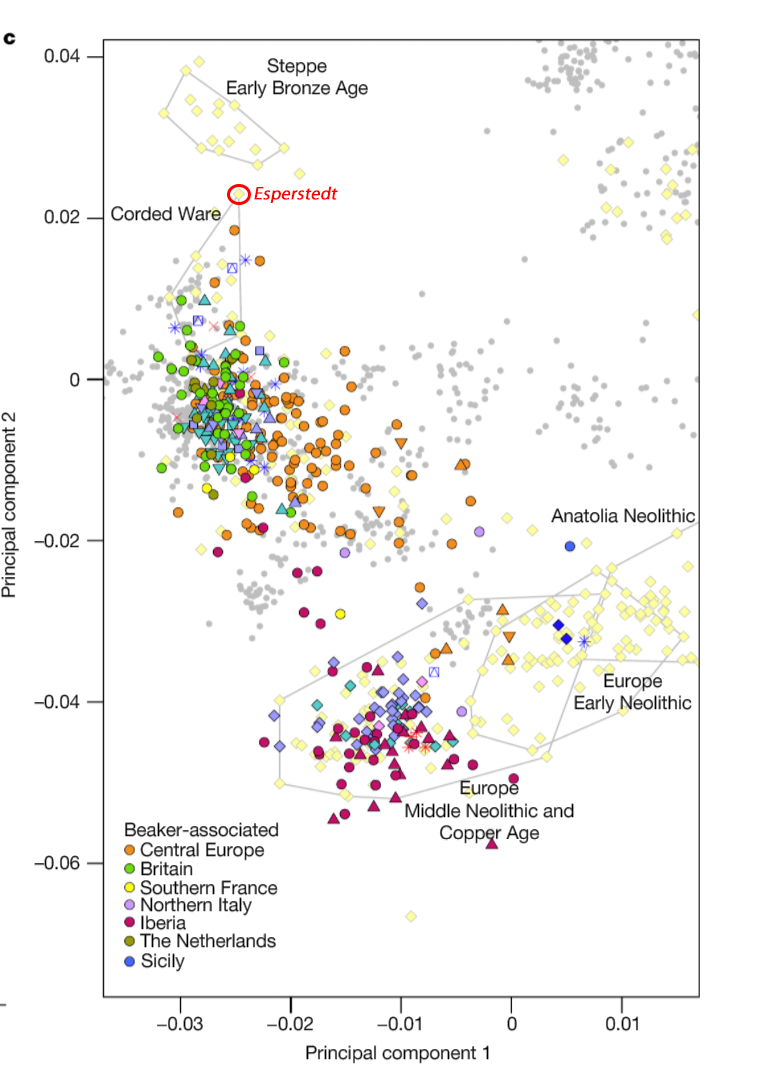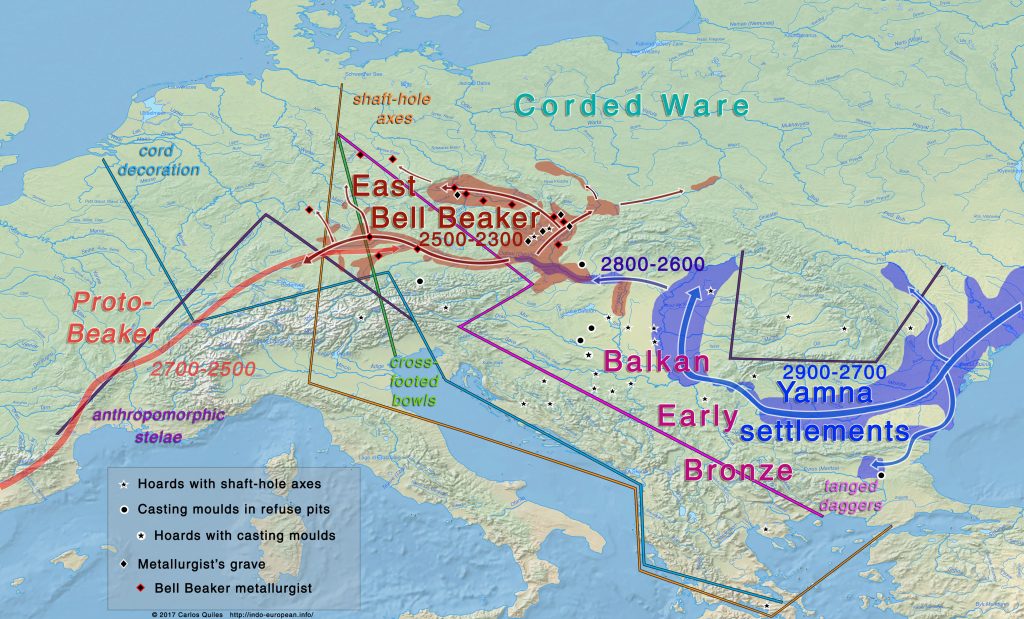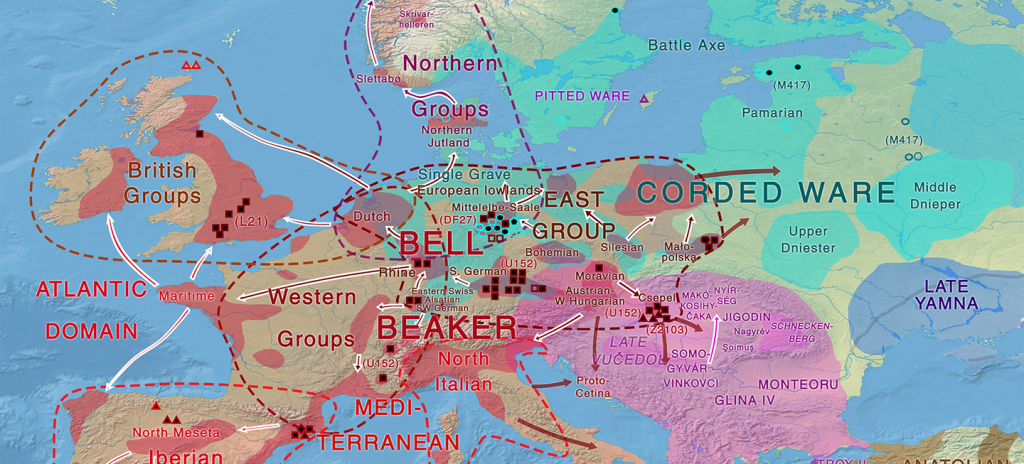The official papers Olalde et al. (Nature 2018) and Mathieson et al. (Nature 2018) have appeared. They are based on the 2017 preprints at BioRxiv The Beaker Phenomenon And The Genomic Transformation Of Northwest Europe and The Genomic History Of Southeastern Europe respectively, but with a sizeable number of new samples.
Papers are behind a paywall, but here are the authors’ shareable links to read the papers and supplementary materials: Olalde et al. (2018), Mathieson et al. (2018).
NOTE: The corresponding datasets have been added to the Reich Lab website. Remember you can use my drafts on DIY Human Ancestry analysis (viz. Plink/Eigensoft, PCA, or ADMIXTURE) to investigate the data further in your own computer.

I don’t have time to analyze the samples in detail right now, but in short they seem to convey the same information as before: in Olalde et al. (2018) the pattern of Y-DNA haplogroup and steppe ancestry distribution is overwhelming, with an all-R1b-L23 Bell Beaker people accompanying steppe ancestry into western Europe.
EDIT: In Mathieson et al. (2018), a sample classified as of Ukraine_Eneolithic from Dereivka ca. 2890-2696 BC is of R1b1a1a2a2-Z2103 subclade, so Western Yamna during the migrations also of R1b-L23 subclades, in contrast with the previous R1a lineages in Ukraine. In Olalde et al. (2018), it is clearly stated that of the four BB individuals with higher steppe ancestry, the two with higher coverage could be classified as of R1b-S116/P312 subclades.
This is compatible with the expansion of Indo-European-speaking Yamna migrants (also mainly of R1b-L23 subclades) into the East Bell Beaker group, as described with detail in Archaeology (and with the population movement we are seeing having been predicted) first by Volker Heyd in 2007.

Also, the resurge of R1a-Z645 subclades in Czech and Polish lands (from previous Corded Ware migrants) accompanying other lineages indigenous to the region – seems to have happened only after the Bell Beaker expansion into these territories, during the Bronze Age, probably leading to the formation of the Balto-Slavic community, as I predicted based on previous papers. The fact that a sample of R1b-U106 subclade pops up in this territory is interesting from the point of view of a shared substrate with Germanic, as is the earlier BB sample of R1b-Z2103 for its connection with Graeco-Aryan dialects.
All this suggests that a North-West Indo-European dialect – ancestor of Italo-Celtic, Germanic, and Balto-Slavic -, supported in Linguistics by most modern Indo-European schools of thought, expanded roughly along the Danube, and later to northern, eastern, and western Europe with the Bell Beaker expansion, as supported in Anthropology by Mallory (in Celtic from the West 2, 2013), and by Prescott for the development of a Nordic or Pre-Germanic language in Scandinavia since 1995.

Maybe more importantly, the fact that only Indo-Iranian-speaking Sintashta-Petrovka (and later Andronovo) cultures were clearly associated with R1a-Z645 subclades, and rather late – after mixing with early Chalcolithic North Caspian steppe groups (mainly East Yamna and Poltavka herders of R1b-L23 subclades) – gives support to the theory that Corded Ware (and probably the earlier Sredni Stog) groups did not speak or spread Indo-European languages with their migration, but most likely Uralic – as seen in recent papers on the much later arrival of haplogroup N1c – (compatible with the Corded Ware substrate hypothesis), adopting Indo-Iranian by way of cultural diffusion or founder effect events.
As Sheldon Cooper would say,
Under normal circumstances I’d say I told you so. But, as I have told you so with such vehemence and frequency already the phrase has lost all meaning. Therefore, I will be replacing it with the phrase, I informed you thusly
I informed you thusly:
- Indo-European demic diffusion model, 3rd edition (revised October 2017)
- The Indo-European demic diffusion model, and the “R1b – Indo-European” association
- The concept of “Outlier” in Human Ancestry (III): Late Neolithic samples from the Baltic region and origins of the Corded Ware culture
- Science and Archaeology (Humanities): collaboration or confrontation?
- Massive Migrations? The Impact of Recent aDNA Studies on our View of Third Millennium Europe
- Expansion of peoples associated with spread of haplogroups: Mongols and C3*-F3918, Arabs and E-M183 (M81)
- The renewed ‘Kurgan model’ of Kristian Kristiansen and the Danish school: “The Indo-European Corded Ware Theory”
- Correlation does not mean causation: the damage of the ‘Yamnaya ancestral component’, and the ‘Future America’ hypothesis
- New Ukraine Eneolithic sample from late Sredni Stog, near homeland of the Corded Ware culture
- Something is very wrong with models based on the so-called ‘Yamnaya admixture’ – and archaeologists are catching up (II)
- Germanic–Balto-Slavic and Satem (‘Indo-Slavonic’) dialect revisionism by amateur geneticists, or why R1a lineages *must* have spoken Proto-Indo-European
- Heyd, Mallory, and Prescott were right about Bell Beakers